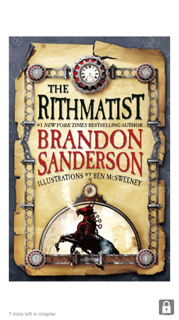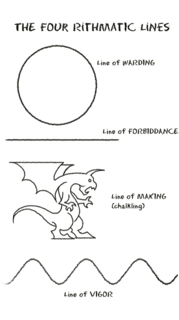March 09, 2016


One of the neat Rithmatic illustrations in the book. This one appears early in the text, as you read further and learn more the sketches get much more detailed and intricate in what they show.
I enjoyed The Rithmatist, though it didn’t knock me out in the same way Mr. Sanderson’s Mistborn trilogy did. Which is a bit of an unfair comparison because the Mistborn books are an epic fantasy trilogy full of marvelous writing, exciting magic, lots of battle action, intriguing politics, and so much more awesomeness. Plus all the creative twists and memorable characters you could ever hope to read about. But, this write-up is not about those books (see link below for my Mistborn write-up). It’s about The Rithmatist.
This novel is written for middle grade readers so it’s for the most part appropriate and approachable for 8 to 9 yr olds and up. There is plenty of neat, imaginative work here, specifically with the great detail Mr. Sanderson gives us regarding his chalk magic system. Rithmatists in the book are chalk magicians, meaning they can draw circles and lines on the ground and use these as defense against attacks drawn by others. Offensive moves are made by Chalklings, which are creatures such as spiders, dragons, or anything the Rithmatist can think of and draw quickly, that move about on the ground to carry out commands specified by the magician. A Rithmatist can also draw certain lines which shoot forth to attack their opponents. I’ll admit, as I describe this, it seems a bit strange and maybe even a little silly. However, the author truly does a remarkable job of explaining this system and includes cool diagrams before each chapter which further explain things and allow us to visualize exactly what the Rithmatists are doing.
The novel’s main character is a smart, resourceful 16 yr old named Joel who, though he is not a Rithmatist himself, is fascinated and almost obsessed with this magic system, so he’s learned all there is to know about it. This becomes vital to the story when a mysterious rogue magician who is using chalk magic for evil purposes begins capturing students at Joel’s school, putting everyone in sudden danger. Joel’s knowledge and desire to help wedges him right in the middle of the mystery, working with a struggling, overly dramatic Rithmatist student named Melody and a brilliant, eccentric professor named Fitch to solve the crime.
As I wrote at the top, overall I enjoyed this book despite a couple sticking points. I have to mention this again--the great chalk magic system is fun, unique, and well-described. Also, Joel is a good, admirable character who matures and changes for the better as a result of the story. Where things get a little bogged down are the slow, studious pace of the book and the religious undertones popping up behind the Rithmatist system.
Joel, Melody, and Fitch spend a lot of time investigating clues, reading books, and talking. There are some small changes of pace in the story related to the student disappearances and other investigative activity, but this all happens mainly on the side. And then the trio thinks about what has happened and discusses the events. Surprisingly, I still wouldn’t call this book boring because Mr. Sanderson is such a gifted, creative writer who is able to keep us interested. It’s just quite slow and scholarly. The end, though, is outstanding. Action-packed with lots of danger, intrigue and twisty surprises.
There are vague religious undertones to the story as well, which somewhat distract from the main plot. But only if you fixate on these small details, and analyze why they are even in the book, which younger readers probably won’t. There is a “Master” who evidently, for reasons unknown, chooses who is to be a Rithmatist and who isn’t. The way children find out is by stepping into an Inception chamber in a church where they somehow either are or aren’t picked to be a chalk magician, an honor apparently given only to about 1 in a 1000 people. I felt Mr. Sanderson wanted to come up with a new way to introduce magic into the world that maybe we haven’t seen in books before. However it just didn’t develop well enough or clear up any of the vagueness for me, so I found it more unsettling than anything else. Again, this is my writer’s brain breaking down the text and I bet most readers will gloss right over these ambiguous parts.
The story sets up a sequel at the end, so perhaps we will hear more about the origins of Rithmatism in a sequel. While I’m unnecessarily nitpicking, the world which the writer created for the book could use a little clarifying too. It’s kind of a futuristic parallel world where things are similar to the real world but just a few ticks different. Such as the USA is a collection of islands and the trains, taxi cabs and other electronics are complex gear-work steampunk type machines. These are just mentioned for scene and for atmosphere though, so they don’t really distract much. Unless you keep thinking about them and wondering if they have any significance like I did!
In closing, I do recommend The Rithmatist for middle grade eager readers and up, provided they are the more serious, studious type who can enjoy a slightly more complicated book. The action is age safe, just know there are a few scenes where the Chalklings attack people and the book mentions them crawling all over the person and chewing the flesh off their bones. But the descriptions aren’t really gory. And there’s some minor creepy yet not too scary suspense regarding the kidnappings. However nothing is too over the top that a Harry Potter type reader couldn’t handle. All in all, Mr. Sanderson is an excellent writer, extremely detailed and creative, and the cool Rithmatist system with diagrams and everything is by far the best part of the book.
Happy Reading!
In case you are interested:
My review of the Mistborn Trilogy
This novel is written for middle grade readers so it’s for the most part appropriate and approachable for 8 to 9 yr olds and up. There is plenty of neat, imaginative work here, specifically with the great detail Mr. Sanderson gives us regarding his chalk magic system. Rithmatists in the book are chalk magicians, meaning they can draw circles and lines on the ground and use these as defense against attacks drawn by others. Offensive moves are made by Chalklings, which are creatures such as spiders, dragons, or anything the Rithmatist can think of and draw quickly, that move about on the ground to carry out commands specified by the magician. A Rithmatist can also draw certain lines which shoot forth to attack their opponents. I’ll admit, as I describe this, it seems a bit strange and maybe even a little silly. However, the author truly does a remarkable job of explaining this system and includes cool diagrams before each chapter which further explain things and allow us to visualize exactly what the Rithmatists are doing.
The novel’s main character is a smart, resourceful 16 yr old named Joel who, though he is not a Rithmatist himself, is fascinated and almost obsessed with this magic system, so he’s learned all there is to know about it. This becomes vital to the story when a mysterious rogue magician who is using chalk magic for evil purposes begins capturing students at Joel’s school, putting everyone in sudden danger. Joel’s knowledge and desire to help wedges him right in the middle of the mystery, working with a struggling, overly dramatic Rithmatist student named Melody and a brilliant, eccentric professor named Fitch to solve the crime.
As I wrote at the top, overall I enjoyed this book despite a couple sticking points. I have to mention this again--the great chalk magic system is fun, unique, and well-described. Also, Joel is a good, admirable character who matures and changes for the better as a result of the story. Where things get a little bogged down are the slow, studious pace of the book and the religious undertones popping up behind the Rithmatist system.
Joel, Melody, and Fitch spend a lot of time investigating clues, reading books, and talking. There are some small changes of pace in the story related to the student disappearances and other investigative activity, but this all happens mainly on the side. And then the trio thinks about what has happened and discusses the events. Surprisingly, I still wouldn’t call this book boring because Mr. Sanderson is such a gifted, creative writer who is able to keep us interested. It’s just quite slow and scholarly. The end, though, is outstanding. Action-packed with lots of danger, intrigue and twisty surprises.
There are vague religious undertones to the story as well, which somewhat distract from the main plot. But only if you fixate on these small details, and analyze why they are even in the book, which younger readers probably won’t. There is a “Master” who evidently, for reasons unknown, chooses who is to be a Rithmatist and who isn’t. The way children find out is by stepping into an Inception chamber in a church where they somehow either are or aren’t picked to be a chalk magician, an honor apparently given only to about 1 in a 1000 people. I felt Mr. Sanderson wanted to come up with a new way to introduce magic into the world that maybe we haven’t seen in books before. However it just didn’t develop well enough or clear up any of the vagueness for me, so I found it more unsettling than anything else. Again, this is my writer’s brain breaking down the text and I bet most readers will gloss right over these ambiguous parts.
The story sets up a sequel at the end, so perhaps we will hear more about the origins of Rithmatism in a sequel. While I’m unnecessarily nitpicking, the world which the writer created for the book could use a little clarifying too. It’s kind of a futuristic parallel world where things are similar to the real world but just a few ticks different. Such as the USA is a collection of islands and the trains, taxi cabs and other electronics are complex gear-work steampunk type machines. These are just mentioned for scene and for atmosphere though, so they don’t really distract much. Unless you keep thinking about them and wondering if they have any significance like I did!
In closing, I do recommend The Rithmatist for middle grade eager readers and up, provided they are the more serious, studious type who can enjoy a slightly more complicated book. The action is age safe, just know there are a few scenes where the Chalklings attack people and the book mentions them crawling all over the person and chewing the flesh off their bones. But the descriptions aren’t really gory. And there’s some minor creepy yet not too scary suspense regarding the kidnappings. However nothing is too over the top that a Harry Potter type reader couldn’t handle. All in all, Mr. Sanderson is an excellent writer, extremely detailed and creative, and the cool Rithmatist system with diagrams and everything is by far the best part of the book.
Happy Reading!
In case you are interested:
My review of the Mistborn Trilogy

